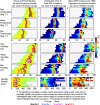The complex relationship between weather and dengue virus transmission in Thailand
- PMID: 23958906
- PMCID: PMC3854883
- DOI: 10.4269/ajtmh.13-0321
The complex relationship between weather and dengue virus transmission in Thailand
Abstract
Using a novel analytical approach, weather dynamics and seasonal dengue virus transmission cycles were profiled for each Thailand province, 1983-2001, using monthly assessments of cases, temperature, humidity, and rainfall. We observed systematic differences in the structure of seasonal transmission cycles of different magnitude, the role of weather in regulating seasonal cycles, necessary versus optimal transmission "weather-space," basis of large epidemics, and predictive indicators that estimate risk. Larger epidemics begin earlier, develop faster, and are predicted at Onset change-point when case counts are low. Temperature defines a viable range for transmission; humidity amplifies the potential within that range. This duality is central to transmission. Eighty percent of 1.2 million severe dengue cases occurred when mean temperature was 27-29.5°C and mean humidity was > 75%. Interventions are most effective when applied early. Most cases occur near Peak, yet small reductions at Onset can substantially reduce epidemic magnitude. Monitoring the Quiet-Phase is fundamental in effectively targeting interventions pre-emptively.
Figures












References
-
- Kroeger A, Nathan MB, Hombach J, Dayal-Drager R, Weber MW. Dengue research and training supported through the World Health Organization. Ann Trop Med Parasitol. 2006;100:S97–S101. - PubMed
-
- Schmitz J, Roehrig J, Barrett A, Hombach J. Next generation dengue vaccines: a review of candidates in preclinical development. Vaccine. 2011;29:7276–7284. - PubMed
-
- Halstead SB. Pathogenesis of dengue: challenges to molecular biology. Science. 1988;239:476–481. - PubMed
Publication types
MeSH terms
LinkOut - more resources
Full Text Sources
Other Literature Sources
Medical
Molecular Biology Databases

